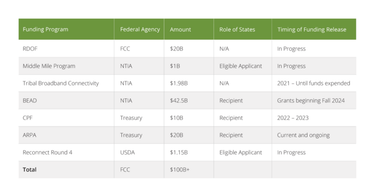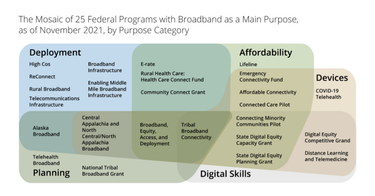
Rural Broadband and the Agriculture and Energy Transitions

Access to affordable, reliable, high-speed internet, in our view, is a fundamental need for the advancement of the U.S. economy. However, nearly a quarter of U.S. households in rural areas and almost 30% of Americans in Tribal lands lack access to high-speed internet, compared to just 1.5% of Americans in urban areas. This disparity is commonly referred to as the Digital Divide: the stark gap between those who can easily access critical technology infrastructure, and those who cannot.*
This system-level divide expands beyond connectivity itself, as reliable and affordable high-speed internet supports major industries, including education, healthcare, and manufacturing, by connecting rural population centers to global markets, and it can facilitate sector transitions to more sustainable practices. We believe high-speed internet is critical for advancing energy and agricultural transitions, as it helps enable smart technologies and real-time data analysis that can enhance efficiency and sustainability in these sectors.
Despite governmental backing and financing initiatives, accessing and appropriately deploying funds into rural broadband development remains challenging, as local operators need adequate support on both funding and operations to successfully implement large-scale infrastructure projects.
This is why S2G is proud to announce our lead investment into Amperage. With its integrated full-service rural broadband platform, Amperage aims to address challenges in project development by investing directly in broadband infrastructure and leveraging partnerships and operational expertise to advance infrastructure projects and enhance connectivity in underserved areas. We view broadband connectivity as an integral “unlock” to the agricultural and energy transition sectors, among others, and are excited to support the Amperage team in advancing their platform to help close the Digital Divide.
Unlocking Sector Transitions
In our view, high-speed internet is critical not only in support of socioeconomic benefits, but also sector transitions.
Energy
Broadband networks are essential for operating energy-efficient technologies and implementing smart-grid capabilities, thereby reducing carbon emissions and creating energy cost savings.
Web-enabled smart-grid technologies, including smart thermostats, heat pumps, electric water heaters, and distributed energy resources like rooftop solar and storage, have the potential to unlock high levels of energy efficiency for residential, commercial, and industrial utility customers. These connected and automated devices can provide flexibility to the power system by turning off at peak time or switching on when renewable output is high, thereby facilitating the intergeneration of renewables, helping alleviate grid congestion, and reducing peak consumption, which is often met with costly, CO2 emitting power plants.
Modernized energy efficiency and smart-grid programs also rely on streamlined data collection, automated centralized controls, and two-way customer communications between utilities and consumers, which require an internet connection, thereby making broadband access a prerequisite for a modernized electric grid. Benefits of a modernized electric grid can include a more reliable and efficient delivery of electricity, reduced power outages, better resilience to storms, a quicker return to power following an outage, and increased grid capacity through reduced congestion.
Improving energy efficiency in rural homes through broadband-enabled devices can deliver the added benefit of providing significant cost savings to the utility customers. This is especially important in rural areas where households spend 40% more of their paychecks than urban households on energy bills. Beyond households, public institutions like hospitals and schools can cut their energy usage with energy efficiency devices, saving costs for local governments and taxpayers.
The growth in data center demand and AI only seems to exacerbate the need for broadband infrastructure, in our view. Data centers, which require substantial amounts of energy to operate, and AI applications, which often demand real-time processing and vast data management capabilities, are both putting additional strain on energy infrastructure. Rural areas are significantly affected by the additional power demand from data centers and AI as many new data centers are being built in rural areas partly because rural locations can offer cheaper land and energy and proximity to renewable energy sources, which are essential for the operation of these large facilities. High-speed internet connectivity supports the operation of these facilities by enabling efficient data transmission and management, as well as improved energy efficiency to minimize strain on rural energy infrastructure.
Agriculture
Beyond just the energy transition, we believe rural broadband development is an integral enabler of the agricultural transition. Broadband connectivity allows farmers to use advanced technologies like GPS, IoT sensors, and data analytics to optimize planting, irrigation, and harvesting, leading to increased efficiency and productivity. It also facilitates real-time communication with suppliers and markets, supports remote monitoring of farm operations, and provides access to online education and resources, ultimately fostering innovation and competitiveness in the agricultural sector.
That said, even with the abundance of benefits that could come from expanded rural broadband access, we believe internet service providers (ISPs) are unlikely to deploy broadband infrastructure in low-population areas without financial support to offset the high capex costs and enable ISPs to generate a return on their investments.
Background on the Digital Divide
Broadband connectivity is primarily delivered through private sector ISPs that build infrastructure and provide internet services to surrounding populations. Building broadband networks is a capex-intensive activity, and ISPs generate an economic return on their investments by charging an internet service fee to the population that the networks serve. In areas of low population density, ISPs have historically shied away from investing capital to build networks, as there are relatively few customers to subscribe to the service, and therefore there is limited visibility into earning economic return. As a result, 42 million Americans have no broadband access.
Since 2020, programs such as the Bipartisan Infrastructure Law, The American Rescue Plan Act, and the Rural Digital Opportunity Fund, recognize the vital need for rural communities to access digital resources. The Federal Government has allocated over $100 billion from 2020 to 2024 to support broadband deployment, therefore in hopes of making it more economically feasible for rural ISPs to offer services to previously bypassed communities.

Challenges to Rural Broadband Development
In a 2022 study, the US Government Accountability Office (GAO) found that over 100 federal programs, across 15 agencies support broadband efforts, some of which are highlighted below.

Despite numerous programs and federal investment, accessing broadband funding remains challenging. Programs themselves vary in their definitions of eligible areas, populations, and required broadband speeds. Furthermore, much of the available funding, like from BEAD, RDOF, and ARPA programs, is distributed at the state level, and many states lack dedicated broadband offices to manage the funds effectively, facing tight deadlines and coordination challenges across multiple government levels and ISPs.
Additionally, broadband grant programs tend to require a percentage of matching funds to cover the portion of the project that is not covered by the grant funds. Small ISPs may not be able to provide match capital from their own balance sheets and therefore need to find outside equity and / or debt investors to be awarded the grant. The ISPs may also face challenges in securing outside private capital due to investors’ possible unfamiliarity with the broadband industry’s nuances, potentially leading to a perceived higher risk and therefore a higher cost of capital.
These factors make it difficult to bridge the Digital Divide, even with significant headline financial support from the federal government.
Introducing Amperage
Amperage is an early-stage broadband infrastructure investment company committed to bridging the Digital Divide through fit-for-purpose partnerships tailored to supporting the buildout of rural broadband infrastructure. Through its comprehensive platform, Amperage is seizing the vast potential of the broadband fiber market, leveraging targeted investments and fostering collaborations with rural broadband stakeholders nationwide.
At the core of Amperage is a vibrant team with a commitment to expanding broadband access by leveraging their diverse expertise to revolutionize connectivity solutions and redefine the boundaries of digital access. See our Entrepreneur Spotlight interview with Amperage Co-Founder Brad Powell.
Amperage offers a full stack of solutions (financing, infrastructure deployment, and client success) to help rural ISPs and cooperatives accelerate their deployment of digital infrastructure through an investment model and drive operation and management of critical infrastructure projects.
Financing and Match Capital
Amperage seeks to provide the required match capital through its investors and financial institutions. Amperage invests directly into the ISPs, and facilitates the necessary financing, to complete and operate an advanced broadband network in rural communities.
Infrastructure
Through its Ascension platform, Amperage offers an array of project management services aiming to guarantee the success of network build-outs, solve for gaps in expertise and resources at ISPs, and maximize value creation. Amperage is active in building local and regional relationships and engaging with communities to help navigate complex state-level funding programs, streamline the development process, and scale and operate the broadband network.
Client Success
Even with grant funding, ISPs still need to generate ongoing cashflows from internet subscribers. Amperage has a dedicated platform, Milestone, geared to expand operators’ customer base by educating more households on the benefits of subscribing to broadband services.
Amperage has already put its solutions into practice through its first investment into Aristotle Broadband, whose customer base Amperage seeks to grow to about 25,000 subscribers, up from 3,000 today.
We believe this commitment is a clear example of the Amperage model at scale.

S2G’s Partnership with Amperage
We believe the Amperage team, platform, and model are well-suited to solve the main challenges limiting ISPs from bringing broadband to rural communities, thus delivering the benefits of high-speed internet access.
We see broadband connectivity as a crucial enabler for the transitions of the agriculture and energy sectors, as well as essential infrastructure for local and regional economies. We are excited to support the Amperage team in enhancing their platform to help bridge the Digital Divide.
* Lloyd Morrisett, the former president of the Markle Foundation, is generally regarded to have coined the term “digital divide,” which he noted is a gap between the information “haves” and “have-nots.”



